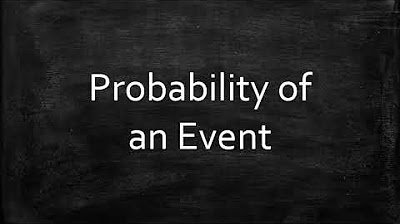Tossing a Fair Coin
Summary
TLDRThe video script explores the concept of probability through the experiment of tossing a fair coin multiple times. It defines a fair coin and explains how to calculate the probability of getting a certain number of heads or tails. The script uses the example of four tosses to illustrate how to find probabilities for zero to four heads, introducing the concept of combinations to determine the number of outcomes. The general formula for finding the probability of k heads in n tosses is presented, with an example of five heads in nine tosses. The script concludes by emphasizing the real-life applicability of coin toss experiments to model various scenarios.
Takeaways
- 🎲 A fair coin has two equally likely outcomes: heads or tails.
- 🔢 The probability of getting a certain number of heads (k) in n tosses is calculated using combinations.
- 📊 The sample space for four coin tosses consists of 16 possible outcomes.
- 💡 The probability of zero heads in four tosses is found by dividing the number of zero-head outcomes by 16.
- 📈 The number of ways to get two heads in four tosses is represented as '4 choose 2', which is 6.
- 🔑 The concept of combinations is key to calculating probabilities in coin toss experiments.
- 🧮 The formula for the probability of k heads in n tosses is derived from the combinations formula.
- 🌐 Real-life experiments can often be modeled by coin tosses, making these probability calculations applicable.
- 📝 The probability of getting five heads in nine tosses is 24.6%, as an example of applying the formula.
- 📚 The significance of these calculations lies in their ability to model and predict outcomes in various experiments.
Q & A
What is a fair coin?
-A fair coin is a coin with two equally likely outcomes, typically heads and tails.
How many outcomes are there when tossing a fair coin four times?
-There are 16 possible outcomes when tossing a fair coin four times, as each toss has 2 possible outcomes and 2^4 equals 16.
What is the probability of getting no heads in four coin tosses?
-The probability of getting no heads in four coin tosses is found by dividing the number of outcomes with no heads by the total number of outcomes, which is 1/16.
How can you find the probability of getting a certain number of heads in a series of coin tosses?
-The probability of getting a certain number of heads in a series of coin tosses is found by dividing the number of outcomes with that specific number of heads by the size of the sample space.
What is the sample space for four coin tosses?
-The sample space for four coin tosses consists of all possible outcomes of the tosses, which are HHHH, HHTT, HHTH, HTHH, HTHT, HTTH, THHH, THHT, THTH, THTT, TTHH, TTHT, TTTH, TTTT.
How many ways are there to get two heads out of four coin tosses?
-There are six ways to get two heads out of four coin tosses, which is the same as selecting two tosses out of four for heads, denoted as '4 choose 2'.
What is meant by '4 choose 2' in the context of coin tosses?
-'4 choose 2' refers to the number of ways to select two tosses out of four for heads, which is a combination and equals 6.
How can the combinations formula be used to find the probability of getting a certain number of heads?
-The combinations formula can be used to find the number of ways to get a certain number of heads, which is then used as the numerator in the probability calculation.
What is the general formula for finding the probability of getting k heads in n coin tosses?
-The general formula for finding the probability of getting k heads in n coin tosses is P(k heads in n tosses) = (n choose k) / 2^n.
Can you provide an example of using the formula to find the probability of getting five heads in nine coin tosses?
-Yes, using the formula, the probability of getting five heads in nine coin tosses is calculated as (9 choose 5) / 2^9, which equals 24.6%.
What is the significance of understanding the probability of coin tosses in modeling real-life experiments?
-Understanding the probability of coin tosses is significant because many real-life experiments can be modeled by a coin toss, providing a basis for predicting outcomes in various scenarios.
Outlines

此内容仅限付费用户访问。 请升级后访问。
立即升级Mindmap

此内容仅限付费用户访问。 请升级后访问。
立即升级Keywords

此内容仅限付费用户访问。 请升级后访问。
立即升级Highlights

此内容仅限付费用户访问。 请升级后访问。
立即升级Transcripts

此内容仅限付费用户访问。 请升级后访问。
立即升级浏览更多相关视频

Experimento Aleatorio, Espacio Muestral, Evento o Suceso y Probabilidades

Tossing an Unfair Coin

Peluang [Part 2] - Peluang Empirik (Frekuensi Relatif)

Probability of an Event

Principios de Adición y Multiplicación (Suma y Producto) - Nivel 2A

Percobaan, Ruang Sampel dan Kejadian ||Materi, Soal & Pembahasan||
5.0 / 5 (0 votes)
